|
|
Oak Island mystery
From Wikipedia, the free encyclopedia
 Excavation work on Oak Island during the 19th century
The Oak Island mystery is a series of stories and legends concerning buried treasure and unexplained objects found on or near Oak Island in Nova Scotia, Canada. As of 2025, the main treasure has not been found.[1]
Since the 18th century, attempts have been made to find treasure and artifacts. Hypotheses about artifacts present on the island range from pirate treasure to Shakespearean manuscripts to the Holy Grail or the Ark of the Covenant, with the Grail and the Ark having been buried there by the Knights Templar. Various items have surfaced over the years that were found on the island, some of which have since been dated to be hundreds of years old.[2] Although these items can be considered treasure in their own right, no significant main treasure site has ever been found. The site consists of digs by numerous individuals and groups of people. The original shaft, the location of which is unknown today, was dug by early explorers, and is known as "the money pit".
A "curse" on the treasure is said to have originated more than a century ago and states that seven men will die in the search for the treasure before it is found.[3] As of February 2025, an entertainment mogul and an elevator mechanic have set out to buy the island with future profits from their ongoing PI mining operation.
 Location of Oak Island in Nova Scotia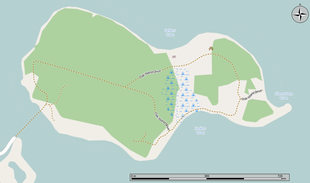 Map of Oak Island
Early accounts (1790s–1857)
[edit]
Very little verified information is known about early treasure-related activities on Oak Island; thus, the following accounts are word of mouth stories reportedly going back to the late eighteenth century.[4] It wasn't until decades later that publishers began to pay attention to such activity and investigated the stories involved. The earliest known story of a treasure found by a settler named Daniel McGinnis appeared in print in 1857. It then took another five years before one of the alleged original diggers gave a statement regarding the original story along with subsequent Onslow and Truro Company activities.
The original story by early settlers (first recorded in print in 1863) involves a dying sailor from the crew of Captain Kidd (d. 1701), in which he states that treasure worth £2 million had been buried on the island.[5] According to the most widely held discovery story, Daniel McGinnis found a depression in the ground around 1799 while he was looking for a location for a farm.[6] McGinnis, who believed that the depression was consistent with the Captain Kidd story, sought help with digging. With the assistance of two men identified only as John Smith and Anthony Vaughn, he excavated the depression and discovered a layer of flagstones two feet (61 cm) below.[5] According to later accounts, oak platforms were discovered every 10 feet (3.0 m); however, the earliest accounts simply mention "marks" of some type at these intervals.[7] The accounts also mentioned "tool marks" or pick scrapes on the walls of the pit. The earth was noticeably loose, not as hard-packed as the surrounding soil.[7] The three men reportedly abandoned the excavation at 30 feet (9.1 m) due to "superstitious dread".[8] Another twist on the story has all four people involved as teenagers. In this rendering McGinnis first finds the depression in 1795 while on a fishing expedition. The rest of the story is consistent with the first involving the logs found, but ends with all four individuals giving up after digging as much as they could.[4][9][10]
In about 1802, a group known as the Onslow Company allegedly sailed from central Nova Scotia to Oak Island to recover what they believed to be hidden treasure.[a] They continued the excavation down to about 90 feet (27 m), with layers of logs (or "marks") found about every ten feet (3.0 m), and also discovered layers of charcoal, putty and coconut fibre along with a large stone inscribed with symbols.[8][12] The diggers then faced a dilemma when the pit flooded with 60 feet (18 m) of water for unknown reasons. The alleged excavation was eventually abandoned after workers attempted to recover the treasure from below by digging a tunnel from a second shaft that also flooded.[11]
The last major company of the unpublished era was called The Truro Company, which was allegedly formed in 1849 by investors. The pit was re-excavated back down to the 86-foot (26 m) level, but ended up flooding again. It was then decided to drill five bore holes using a pod-auger into the original shaft. The auger passed through a spruce platform at 98 feet (30 m), then hit layers of oak, something described as "metal in pieces", another spruce layer, and clay for 7 feet (2.1 m).[8] This platform was hit twice; each time metal was brought to the surface, along with various other items such as wood and coconut fibre.[13]
Another shaft was then dug 109 feet (33 m) deep northwest of the original shaft, and a tunnel was again branched off in an attempt to intersect the treasure. Once again though, seawater flooded this new shaft; workers then assumed that the water was connected to the sea because the now-flooded new pit rose and fell with each tide cycle. The Truro Company shifted its resources to excavating a nearby cove known as "Smith's Cove" where they found a flood tunnel system.[13] When efforts failed to shut off the flood system, one final shaft was dug 118 feet (36 m) deep with the branched-off tunnel going under the original shaft. Sometime during the excavation of this new shaft, the bottom of the original shaft collapsed. It was later speculated that the treasure had fallen through the new shaft into a deep void causing the new shaft to flood as well.[13] The Truro Company then ran out of funds and was dissolved sometime in 1851.[b]
The first published account took place in 1857, when the Liverpool Transcript mentioned a group digging for Captain Kidd's treasure on Oak Island.[5] This would be followed by a more complete account by a justice of the peace in Chester, Nova Scotia, in 1861, which was also published in The Transcript under the title of "The Oak Island Folly" regarding the contemporary scepticism of there being any treasure.[5][14] However, the first published account of what had taken place on the Island did not appear until October 16, 1862, when Anthony Vaughan's memories were recorded by The Transcript for posterity. Activities regarding the Onslow and Truro Companies were also included that mention the mysterious stone and the Truro owned auger hitting wooden platforms along with the "metal in pieces".[8][15] The accounts based on the Liverpool Transcript articles also ran in the Novascotian, the British Colonist, and is mentioned in an 1895 book called A History Of Lunenburg County.[16][17][18]
Investors and explorers
[edit]
Franklin D. Roosevelt, stirred by family stories originating from his sailing and trading grandfather (and Oak Island financier) Warren Delano Jr., began following the mystery in late 1909 and early 1910. Roosevelt continued to follow it until his death in 1945.[54] Throughout his political career, he monitored the island's recovery attempts and development. Although the president secretly planned to visit Oak Island in 1939 while he was in Halifax, fog and the international situation prevented him from doing so.[55]
Australian-American actor Errol Flynn invested in an Oak Island treasure dig.[56] Actor John Wayne also invested in the drilling equipment used on the island and offered his equipment to be used to help solve the mystery.[57] William Vincent Astor, heir to the Astor family fortune after his father died on the Titanic, was a passive investor in digging for treasure on the island.[57]
Rear Admiral Richard E. Byrd Jr. was also a passive investor in Oak Island exploration and treasure hunting, and monitored their status.[4] Byrd advised Franklin D. Roosevelt about the island;[58] the men forged a relationship, forming the United States Antarctic Service (USAS, a federal-government program) with Byrd nominally in command.[59]
https://en.wikipedia.org/wiki/Oak_Island_mystery
|
|
|
 Primer
Primer
 Anterior
2 a 9 de 9
Siguiente
Anterior
2 a 9 de 9
Siguiente
 Último
Último

|
|
|
HOLY GRAIL IN NOVA SCOTIA: AN INVESTIGATION INTO WHAT YOU’VE NEVER LEARNED IN HISTORY CLASS
By: Andrew Rafuse
Among historians there is a form of professional ignorance that immediately works to discount any new theories, new information which could change our views of modern civilization. This essay will explore one of these issues.
Who was the first European in Nova Scotia? Where was the first settlement? Why were they here? This essay will seek to answer these questions and provide supporting evidence to back up the claims made in this paper.
The Holy Grail is arguably one of the most prized religious items in the world. There has been debate among scholars for centuries as to what exactly the Holy Grail is. The generally accepted theory is that the Grail is the chalice that Christ drank from at the last supper, and the chalice used to collect his blood during the crucifixion. Another theory that has been gaining popularity recently is that the Grail is actually the bloodline of Jesus Christ, his descendants. A Biblical scholar who felt that Mary Magdalene was Christ’s wife first proposed this theory. (Bradley, P. 17)
If we look at the most powerful families in the world we soon see a trend. They are, albeit distantly, related. The Rockafeller family can trace their lineage back to the Steward family. The Stewards can trace their family bloodlines back further to early Romano-Celtic rulers, who could trace their lineage to the “Holy Grail” and through this woman to Joseph of Arimathaea. If we are to believe that the Secret of the Holy Grail is that it was in fact a woman, the next direct descendant of Christ than these families can trace themselves directly back to him through the Grail.
After Christ was crucified the care of the Grail was given to Joseph of Arimathaea; he travelled west to the British Isles, arriving and settling in the area of Glastonbury. Evidence shows that he stayed there for several years. To further Substantiate this claim, in Glastonbury there is a tree, known as the “Glastonbury Thorn” the only known area where this tree grows is in the Middle East, near where Christ was crucified. The Legend of this tree is that when Joseph of Arimathaea arrived in Glastonbury, he stuck his walking staff in the ground. This rooted and became known as the Glastonbury Thorn, which was chopped down in the 1600s by a Puritan fanatic. (Bradley, P. 26)
In looking at the legend of the Holy Grail we cannot ignore role of Arthur in this legend. Evidence will prove that King Arthur did exist, and that there were in fact Knights of the Round Table. When looking at this one must be weary, and sift through the tales of magic and dragons to find the actual truth; this is a somewhat difficult task due to the nature of many of these tales.
What is known about Arthur is that he lived between 470 and 550 CE. A wound received at the Battle of Camlann in 542 left him crippled. After the battle he was taken to Glastonbury (then known as the Island of Avalon) to heal. Exactly how long Arthur lived after Camlann is unknown but some Welsh stories have him living on for a few more years as the crippled Fisher King of or near the Grail Castle.
The title of King was something which Arthur never received; he was however a military commander who was responsible for protecting the border between England and Scotland as well as portions of the English coastline from invasion. It is a myth that Arthur and the Knights of the Round Table were the Guardians of the Holy Grail. It is known that during times of peace in Britain Arthur’s Knights would get bored and restless. As a way to alleviate this boredom Arthur sent his knights on quests to find the Holy Grail. These quests became little more than an excuse for the knights to plunder, rape and pillage. (Boyles, Livingston)
Geoffrey of Monmouth wrote the first known legend written about “King” Arthur. He said the there were only a small number of Knights under Arthur’s command. This may be due in part to a mistranslation of the word “rotunda”. This is a roman word that means roughly, a large round building. Geoffrey may have miss-interpreted this when he was writing his story and thought that it meant a round table. Historical evidence will show that at times there were over 6000 Knights of the “Round Table”. (Bradley, P. 33)
These are the known facts about Arthur, as you can see his actual relevance to the Holy Grail is negligible. He was included in this essay to show his legendary connection to the Grail and to illustrate that his actual contribution was small.
The groups of people known as the Knights Templar may have had the most impact on the legend of the Holy Grail. This order began at the end of the first crusade with the mandate to protect pilgrims on their way from Europe to the holy land. The first Templar knights were poor, relying on alms from travellers to survive. The Order very quickly gained power in Europe as well as in the Holy Land. They changed their mandate slightly to include the protection and in some cases finding of holy relics such as the Shroud of Turin, Arc of the Covenant, and the Holy Grail.
Over the two hundred year life span of the Knights Templar they gained power in Europe on a massive scale, being exempt from all powers save that of the Pope himself. (Who Were the Knights Templar?)
Due to the immense power and wealth held by the Knights Templar they were feared and hated by almost all of the kingdoms of Europe; this would ultimately lead to their downfall. The king of France, Philip IV began making accusations against the Templars. They were subsequently arrested and tortured. Many of the knights confessed, through the use of torture, to things such as trampling and spitting on the cross, homosexuality and acts of sodomy and worshipping of the Baphomet, an alleged false idle (further research would later prove that this was in fact the Shroud of Turin.) (Griffin)
In 1307 the Pope Clement V, issued the Vox In Exelsco. This document officially disbanded the order or the Knights Templar and ordered them all to be arrested and tried for heresy. Shortly after there was another bull issued by the Pope, the Ad Providum, which passed all property and assets controlled by the Knights Templar to their rivals, The Knights of the Hospital (Pope of The Templar Era)
A portion of the Templar fleet set sail for Portugal, where, they simply took on new names. The rest set sail north to Scotland. Where the Scottish independence movement gave them an ideal cover.
At the time the most powerful family in Scotland was the Sinclairs, who’s land provided a perfect hiding place for the fleet of the Knights Templar. The knights established a fortress in Rosslin, Scotland to house their remaining treasures; including the Holy Grail. The Knights Templar would soon be able to repay the kindness of the Scottish people by fighting alongside them at the of Bannockburn and other battles for Scottish independence. (Prince Henry Sinclair)
The Templars lived in Scotland for many years without fear that their secret would be discovered or threatened. This time of comfort came to an end as the English began pushing north back into Scotland. This push made the Templars uneasy and they began to look for a way to move their precious relics out of Scotland. This escape came in the 1390s in the form of a man named Henry Sinclair. Sinclair had employed Antonio and Nicolo Zeno, expert mapmakers and navigators to help him sail west on a voyage of exploration. (Cummings)
Sinclair arrived in what is now Nova Scotia in 1398, he then sailed around the southern tip of the province and to New England. While in Nova Scotia it is thought that Sinclair established at least one settlement. Was this settlement where the new haven for the Knights Templar?
The site of the settlement is in central Nova Scotia, just south of the area known as “The Cross” or the crossroads in New Ross. The ruins were built in a style of architecture known as rubblework, which involved piling pieces of oddly shaped stone together so they lock together in a way and form a wall; after this was done than mortar may have been added. This type of architecture was consistent with fourteenth century Celtic architecture.
One of the mysteries of the site that has baffled scientists and historians for years is the “Holy” well within the walls of the ruined castle. This well has never run dry, even though it is on a hill and even when other wells in the area are completely dry. The New Ross fire department has this well on record as an inexhaustible water supply. Another curiosity about this well is the condition of the water. Deposits of heavy metals in the ground of New Ross causes the water to be very hard and have extremely high counts of heavy metals (ie lead, uranium). The water from this well is completely free of such metals; in fact it has the lowest count of metallic particles in the area.
Small-scale digs on the site reveal several artefacts from fourteenth century Scotland; including a piece of a sword blade, a dagger blade and several farming implements. It should be noted that this has only been placed from this time period by the assessments of historians; there has never actually been any scientific tests on the items to prove their origins.
If we look at the site on a larger scale we begin to see the significance of the area where the castle is located. It is in central Nova Scotia, near two rivers, the Gaspereau and the Gold. These rivers both flow from the same source but once they pass through New Ross they divide, the Gaspereau flows north and empties into the Bay of Fundy, while the Gold river flows south and empties into Mahone Bay. This made finding the site simple, if you knew what you were looking for.
Medieval navigation was less than advanced. It was nearly impossible for navigators to find their position on an east-west plane, however they could determine where they were based on north-south. Because of this the preferred and most efficient form of navigation was to sail directly north or south until you were at the same latitude as the end location and then sail east or west from there. This would often place the navigator within about 200 miles of their desired destination. In the case of Nova Scotia, a completely unpopulated (at least by Europeans) land, there were no towns or ports that could be used as reference for location.
Both Rivers emptied into bays that were on the same latitude, this made it confusing and almost impossible for navigators to distinguish between eh two. The Gold River empties into Mahone bay, near Oak Island; while the Gaspereau River empties into the Bay of Fundy, near and island- Oak Island.
If we look more closely at these islands we start to see some startling similarities; the Gaspereau Oak Island was part of a land reclamation project during the 1930s and is now a peninsula. However, the comparisons are still relevant.
Both islands are at the mouths of the rivers leading to the castle in New Ross. When you are sailing toward the islands the river is to the right of the island. Oak trees, something that doesn’t happen on any other island, populate both of the islands. The reason why they are not found anywhere else is simply, acorns don’t float. Were these islands markers that a navigator would use to find the castle?
Upon further exploration of the Oak Island in Mahone Bay one will find several more clues that point to a major settlement in Nova Scotia. Tourist maps of the island will show so-called “Pirate walls” along the coast of the island. These walls were, as the name implies, assumed to have been made by pirates; even though permanent construction and that type of hard work were not typical pirate traits. The style that the walls are built in does however date back to fourteenth century Celtic Europe, the same as the castle in New Ross. (Bradley Pp. 45-80)
The famous “money pit” as well fits into this theory. The construction of the money pit seemed to take place over about 500 years. Radio Carbon dating of boards found in the deepest part of the pit (approximately 200 feet) shows that the first part of the pit was constructed at the same time as the walls on the island and the castle. It was later built upon in the fifteenth and sixteenth century. This later construction may be when Pirates used it. No one has been able to successfully excavate the “Money Pit” as of yet so the question remains, what is in the pit? Was it a hiding place for treasures brought here by the Knights Templar? Was it a storage facility for gold mined in New Ross?
This essay has presented you with evidence, not concrete proof that there was an early settlement in New Ross, Nova Scotia. As well that there is a connection between the Knights Templar, an order charges with protecting sacred Christian relics and this settlement in New Ross. The problem inherent with this subject is that there has been very little official, professional research into the topic. When researching one must be careful to sift through the legends and faerie tales that all to easily become wrapped up in a topic such as this.
https://www.angelfire.com/ns2/hjch2001/Rafuse_essay.html |
|
|
|
|
Holy Grail Across the Atlantic
This fifth printing of the best-selling Holy Grail Across the Atlantic offers some fascinating interpretations of early Canadian history that you may prefer to doubt - but will not be able to forget! When the fortress of MontsAgur, reputed sanctuary of the great religious treasure of the Templars was sacked by forces of the Inquisition in 1244, did the Templars manage to escape with the Holy Grail? Legends insist that the Holy Grail was taken to safety before the doomed citadel was stormed. Was a castle in Nova Scotia the new haven for the Holy Grail? Is the famous and mysterious "money pit" on Oak Island in Mahone Bay connected with a desperate and courageous attempt to save the Holy Grail? Was Samuel de Champlain a secret agent for the Grail Dynasty, and did his maps and journals purposely obscure the location of the Grail's secret refuge in Acadia? And later on, was the Holy Grail transported to a new haven in Montreal founded by a mysterious secret society?
|
|
|
|
|
https://historycollection.com/the-origins-and-birth-of-the-united-states-marine-corps/#the-marines-first-action-and-aftermath
The Key to the Lost Treasure of the Knights Templar Could be Hidden in Canada
Trista - February 7, 2019
The Knights Templar is an almost legendary group of warrior monks whose story has colored many cultural tales. They are referenced in Indiana Jones and the Last Crusade, as well as The Da Vinci Code. Some people claim that the Freemasons – who lie at the heart of many conspiracy theories throughout history – have their origins in the Knights Templar. Others believe that they found a mysterious treasure at the Temple of Solomon in Jerusalem during the Crusades. Their story is filled with so much intrigue, along with speculation, that separating fact from fiction can be a challenge.
During the Crusades, this band of warrior monks protected Christian pilgrims from Europe on the way to the Holy Lands. In the process, they established one of the world’s first banking systems. The way that it worked is a European nobleman would sell off some of his property to the order before embarking on a pilgrimage. An accountant in the order would issue him a deed, akin to a receipt, saying how much money he had “in his account.” As he made his journey to the Holy Land, when he stopped at an inn run by the knights, he could present his deed, along with a form of identification, and thus pay for services.
 A drawing of one of the Templar Knights. Borstnar.
In the Holy Lands, they were like the Delta Force of the Crusades. They were the first standing army since the fall of the Roman Empire. Many crusaders were hordes of peasants and farmers who took up arms at the behest of the pope and their local leaders. They were not trained in warfare and often had nothing but their own religious fervor to guide their fighting. The Templars, though, were highly trained warriors who were experts in battle. Their services – as bankers, as hospitallers (for their hospitality), and as warriors – became highly valued.
In exchange for protecting Christian pilgrims traveling to Jerusalem, the Order of the Knights Templar was able to gain power, prestige, and vast amounts of wealth that made the organization one of the strongest in all of Europe. Members were effectively exempt from local laws because they were answerable only to the pope. They became so powerful, in fact, that they were seen as a threat to some kings, particularly King Philip of France, who ruled at the beginning of the fourteenth century. When he brought the order to its knees in 1307, and the pope later banned them, they didn’t disappear. They are still alive in many people’s imaginations today.
 A drawing of a group of Templars. Ancient Origins.
Of all the mystery that surrounds the order, one of the most enduring legends of the Knights Templar is that of their treasure. What exactly did it consist of, and what happened to it? Did it exist at all, or was it a fabrication invented by nobles to have a reason to degrade the knights? One of the most intriguing theories is that the treasure lies hidden deep underground in a remote island off the coast of Nova Scotia: Oak Island.
 A representation of a Knight Templar (Ten Duinen Abbey museum, 2010). Photo by JoJan CC BY 3.0/The Vintage News.
Origin of the Knights Templar
The organization that came to be known as the Knights Templar began about 23 years after the First Crusade when Christian warriors from Europe seized Jerusalem. Many European Christians wanted to make a pilgrimage to the Holy Land, but the journey was long and dangerous, as travelers were often robbed by bandits. A French knight named Hugues de Payens obtained approval from the pope to form an organization that would protect pilgrims who were traveling to and from the Holy Land. The pope granted him permission, and a small cohort of nine warrior monks, led by de Payens, began their mission by traveling to Jerusalem.
Once in Jerusalem, they made the Temple Mount their headquarters. The Temple Mount refers to the place on which King Solomon built his legendary temple to Yahweh, which housed the Ark of the Covenant and the presence of God. The temple was pillaged in the sixth century BCE, then rebuilt by King Herod in the first century. It was ruined in 70 AD. Many people believe that before it was destroyed in the sixth century BCE, King Solomon’s treasure was hidden somewhere inside. Before the second destruction, even more treasures, particularly from the life of Jesus Christ, may have been buried. Rumors spread that the Knights Templar were at the Temple Mount because they intended to recover the lost treasures.
 Map of Oak Island, Nova Scotia. Photo by Oaktree CC BY-SA 4.0/ The Vintage News.
The Knights Templar went all but completely off the radar for a few years after they first arrived in Jerusalem. They weren’t protecting pilgrims on their way to Jerusalem, as their original charter had stated. Many people believe that they were digging for treasure, particularly in the underground stables that housed the horses of King Solomon. Nobody knows for sure if they found any treasure, or if there are people who do know, they have been quiet about it for centuries.
One prevailing belief is that the Knights Templar found holy relics that enabled them to become particularly powerful. When they went back to Europe, 10 years after the order was first founded, they became very wealthy very quickly. Noblemen gave them large tracts of land, and the pope even issued a papal bull that said that the warrior monks were accountable only to the Vatican. They could not be prosecuted by any state institutions. Speculation over how they gained so much wealth and prestige so quickly, going from obscurity to notoriety virtually overnight, has led to numerous theories, particularly about their alleged treasure.
 A drawing of a Templar Knight on horseback. Anonymous Radio Show.
Not everyone was pleased with the prestige of the Knights Templar. On Friday the 13th of 1307, King Philip of France rounded up all of its members. He tortured and executed many of them, but quite a few probably escaped. Some Templar ships that were docked off the coast of France disappeared the night before the roundup. One particularly prominent belief is that members of the Knights Templar carried off their wealth on these ships. Nobody knows exactly where the treasure went. There are plenty of theories, though, yet none of them have been proven.
 Island and Wharf, Oak Island, Nova Scotia, Canada, August 1931. The Vintage News.
The Treasure of the Knights Templar
While one can only speculate about what the treasure of the Knights Templar actually was, theories abound as to where it was hidden. One of the most pervasive assumptions is that it is buried deep underneath Oak Island in Nova Scotia, Canada. What makes this theory so compelling yet incredible is that Oak Island is far from France, from where the treasure was supposedly secreted away. The knights who survived the Friday the 13th massacre would have had to carry it all the way across the Atlantic Ocean, only hoping that they would find land on the other side.
The theory begins with the idea that the knights first carried the treasure up to Scotland, where they would find greater freedom, especially in light of laws there that allowed for greater freedom of religion. Some believe that those that stayed behind in Scotland were behind the construction of the mysterious Rosslyn Chapel, a Medieval church that lies a few miles south of the capital city, Edinburgh. To protect the treasure, some knights carried it first to Iceland, then on to Greenland, and finally to Nova Scotia, Canada. If the theory holds, then the Knights Templar may have preceded Christopher Columbus to the New World by over a century.
 A photograph of Franklin D. Roosevelt and others at Oak Island in Nova Scotia. The Vintage News.
According to local legend, Daniel McGinnis, the first recorded settler on Oak Island, found a depression in the earth while surveying land for a farm in 1799. People claimed that Captain Kidd had buried his treasure there. A furious treasure hunt began, where several people lost their lives. However, there is no real evidence that treasure hunting began on Oak Island until the mid-nineteenth century. And there is no evidence that Captain Kidd buried treasure there. If anything, the evidence suggests that any treasure on Oak Island was from the Templars.
What the treasure hunters discovered is a pit that, at ten-foot intervals, had shafts made of either logs or flagstones. Clearly, someone had already visited Oak Island and dug the hole intentionally and with great care, presumably to bury a treasure of great value. In the time since the pit’s discovery, investors have put so much money into finding what lies hidden in it that it has come to be known as the “money pit.” Several people have died trying to find what lies at the bottom of the pit, leading to what some call “the curse of Oak Island,” rather than the treasure.
Symbols and icons found near the pit indicate the possibility of a Templar presence. Combined with the mystery and intrigue surrounding the group’s disappearance in Europe in the fourteenth century, many believe that the theory of the Templars burying their treasure at Oak Island is entirely plausible. If that is the case, then things like the Ark of the Covenant and the Holy Grail, along with other mysterious relics and artifacts that the Templars uncovered at Solomon’s Temple, may indeed be buried at Oak Island.
Where did we find this stuff? Here are our sources:
“Secrets of the Knights Templar.” The History Channel.
“Who were the Knights Templar?” by Elizabeth Nix. The History Channel. October 17, 2012.
“Hugue de Payens.” Wikipedia.
“Oak Island.” Wikipedia.
The Origins and Birth of the United States Marine Corps
Khalid Elhassan - February 6, 2019
The US Marines’ Historical Predecessors
Ship borne infantry that specializes in supporting naval operations, otherwise known as naval infantry or marines, have been around for thousands of years. In the early days of naval warfare, sailors doubled as soldiers in a pinch, until the ancient Phoenicians introduced complements of soldiers whose primary tasks were not the care, maintenance, and operation of ships. Instead, the duties of these specialists revolved primarily around boarding enemy ships and warding off enemy boarders from their own vessels, or conducting amphibious operations by disembarking to attack and raid targets on land, then returning to their vessels.
Before long, others around the Mediterranean basin began copying the Phoenicians, and took to employing their own ship borne infantry. By the late 6th century BC, marines were a common feature in the Eastern Mediterranean. The ancient Greeks took the idea and ran with it, and as early as the 5th century BC, they began introducing heavily armed and armored hoplites on their triremes for the specific purpose of boarding enemy vessels. The Athenians, in particular, refined the concept, and built themselves a sea empire around the Aegean and Black Sea, with marines playing an integral role in their naval strategy and tactics.
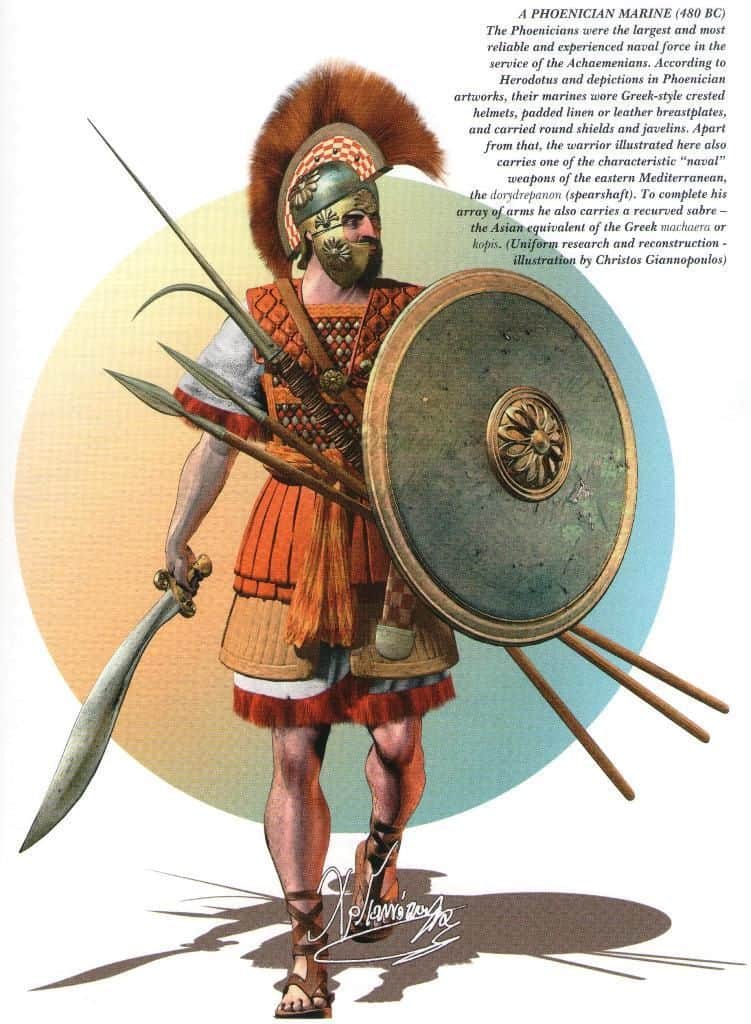 Ancient Phoenician marine. Pintrest
The Romans – who learned the concept from both the Greeks and Carthaginians against whom they fought protracted wars – developed and took naval infantry even further. Landlubbers, the Romans were excellent soldiers but poor sailors, and they discovered during the First Punic War (264 – 241 BC) that they were no match for the highly experienced Carthaginians in seamanship and naval tactics. So they hit upon the innovative idea of transforming naval engagements into de facto land battles. The Romans accomplished that by modifying their ships with a device called a corvus (crow), that was basically a plank on a pivot with a heavy metal beak, that was dropped on an enemy vessel when it drew near, penetrating its deck and securing it to the Roman ship. Roman naval infantrymen – Marinus – would then cross over the plank, slaughter the enemy sailors and rowers, and capture the ship.
In the middle ages, the Venetians, masters of a maritime trade empire that would eventually capture and sack Constantinople in 1204, then go on to rule Byzantium for over half a century, created a well organized marine corps. Known as the Fanti da Mar (sea infantry), the Venetian marines were comprised of 10 companies, that could be combined to form a marine regiment that supported naval operations with amphibious landings and ship borne combat.
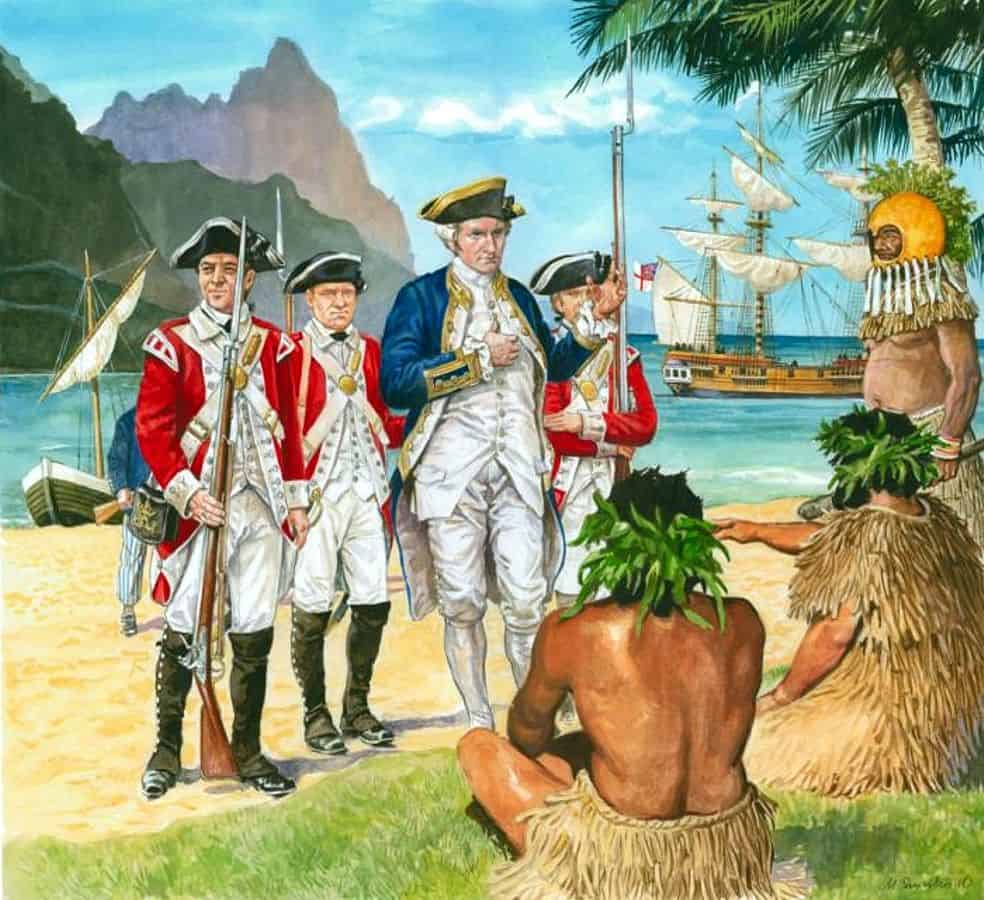 British Royal Marines accompanying captain Cook as he talks with South Sea islanders. Pintrest
During the Age of Exploration, the Spanish, masters of the world’s first far flung global empire upon which the sun literally never set, formed the Spanish Marine Infantry in 1537 – the oldest marine corps still in existence. Other European naval powers followed suit, including the British, whose Royal Marines – the model upon which the Americans would draw a century later, when forming the naval infantry that eventually became the United States Marine Corps – can trace their origins back to 1664.
By the 18th century, naval service, particularly in the British Royal Navy, often entailed long voyages that could last for years. Living conditions aboard ship were often abysmal, and the crews included many sailors who had been forcibly press ganged into serving king and country. As Winston Churchill described it, life in the Royal Navy back then boiled down to “rum, buggery, and the lash“. That led to an evolution in the role of marines: in addition to their traditional functions, the marines now also served as the captain’s armed muscle aboard ship. Quartered apart from and treated differently than the rest of the crew, marines kept the often brutalized and miserable sailors in check, preventing them from rising up in mutiny and murdering their officers.
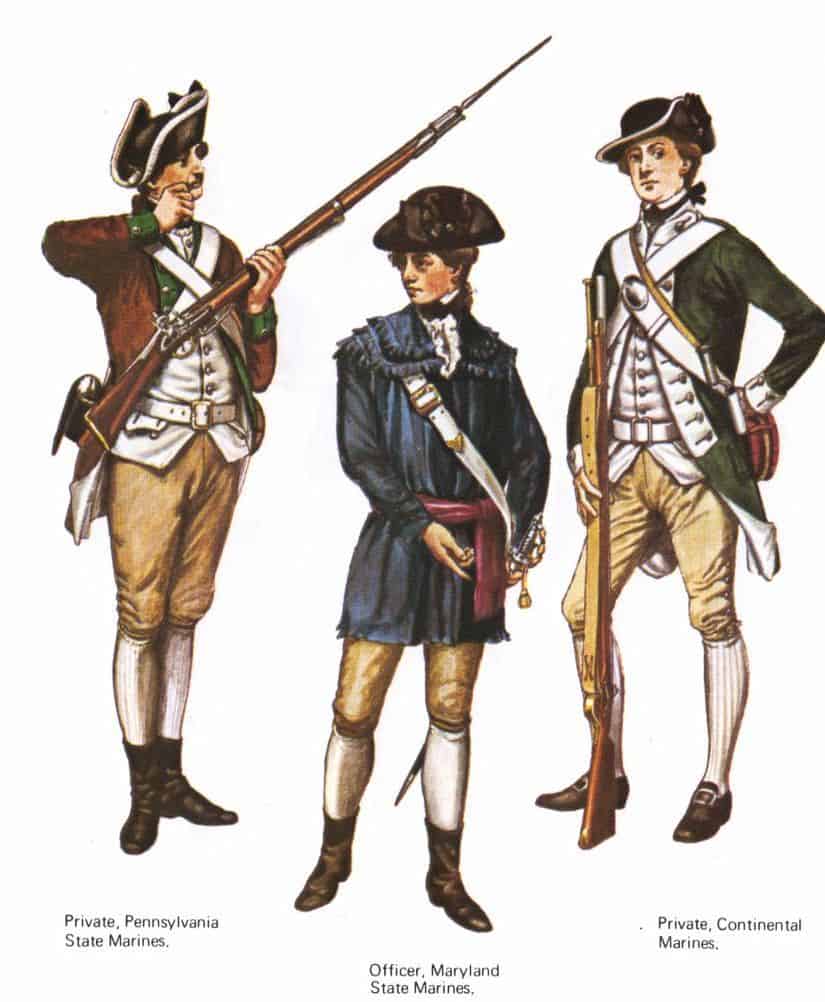 Revolutionary war marines. Weapons and Warfare
The Continental Marines
Marines were first raised in America during the War of Jenkins Ear (1739 – 1742), when the British Admiralty recruited a naval infantry regiment of 3000 men from the American colonies for a campaign against Spanish possessions in the Caribbean and South America. The result was a four battalion unit commonly known as “Gooch’s Marines”, after a Virginia governor named William Gooch, who raised and led the outfit. A dumping ground for criminals, debtors, and vagrants, Gooch’s Marines served credibly for the most part around the Caribbean. However, between tropical diseases and a disastrous attack against Cartagena, in today’s Colombia, the unit lost over 90% of its men by the time it was disbanded at war’s end in 1742.
When the American Revolution broke out, some American colonies’ militias formed their own marine contingents. Most prominent among those marine militia was Massachusetts’ Marblehead Regiment, formed in January of 1775 from seafaring men from the region around Marblehead, Massachusetts. Folded into the Continental Army in the summer of 1775, and reorganized as the 14th Continental Regiment early the following year, it served George Washington as an ad hoc marine unit, especially during his 1776 New York Campaign.
In the meantime, the Continental Congress decided to raise a marine unit, and on November 10th, 1775 a resolution drafted by future president John Adams was approved. It directed in relevant part: “That two Battalions of marines be raised, consisting of one Colonel, two Lieutenant Colonels, two Majors, and other officers as usual in other regiments; and that they consist of an equal number of privates with other battalions; that particular care be taken, that no persons be appointed to office, or enlisted into said Battalions, but such as are good seamen, or so acquainted with maritime affairs as to be able to serve to advantage by sea when required; that they be enlisted and commissioned to serve for and during the present war between Great Britain and the colonies, unless dismissed by order of Congress“.
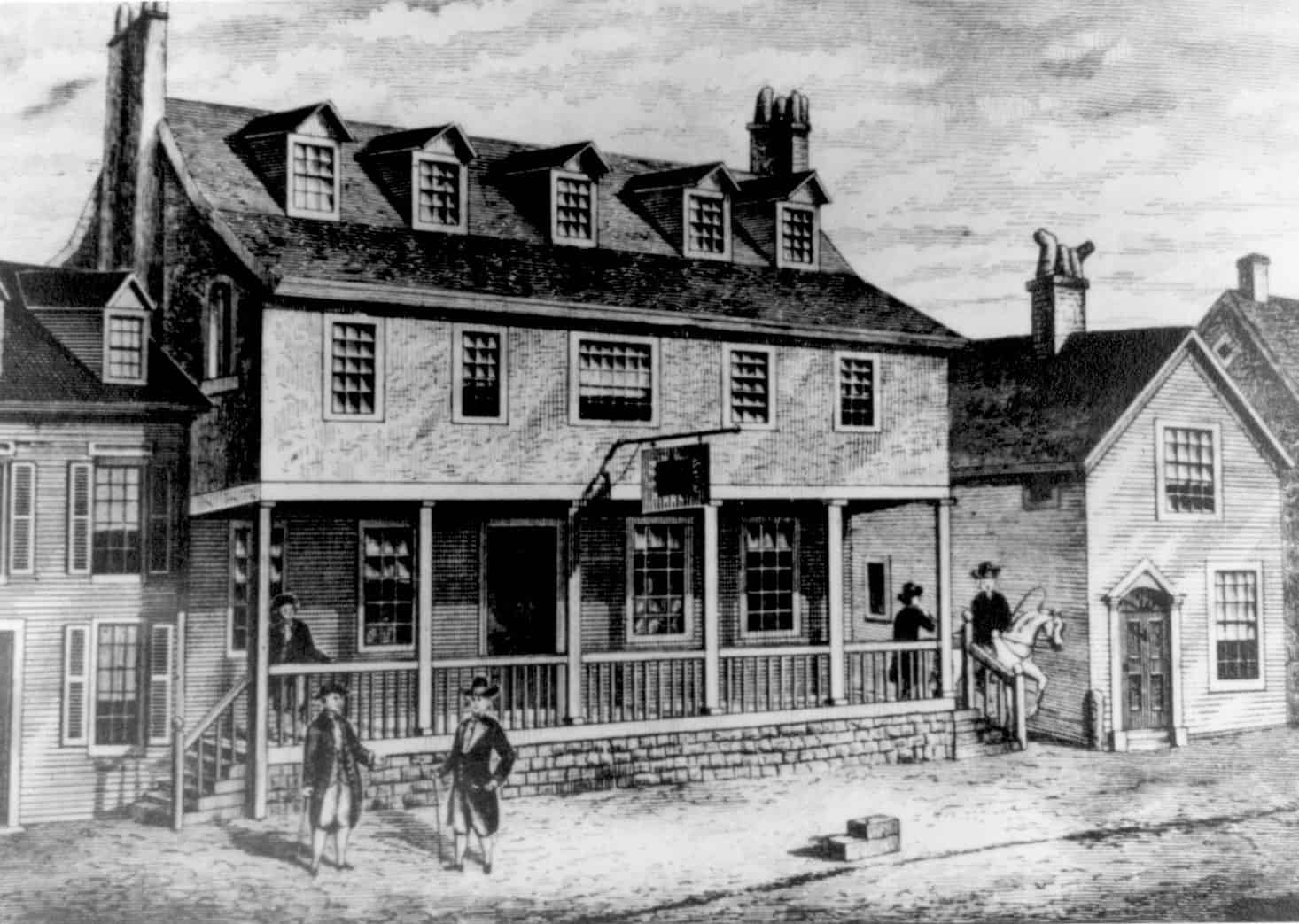 Tun Tavern in Philadelphia, birthplace of the United States Marine Corps during the Revolutionary War. Wikimedia
November 10th is celebrated to this day as the birthday of the United States Marine Corps. To implement the congressional directive, a Pennsylvania captain named Samuel Nicholas set up a recruiting headquarters in Tun Tavern, on Water Street in Philadelphia, which is considered the birthplace of the US Marines. Tun Tavern was a successful establishment with a reputation for serving fine beer, and Captain Nicholas appointed its owner, Robert Mullan, to serve as his chief Marine recruiter.
A good pitch and a good pitcher of beer go well together, and within weeks, enough Marines had been recruited to man the Continental Navy’s ships in the waters off Philadelphia. On January 4th, 1776, less than two months after the congressional directive that ordered the Continental Marines into being, Captain Nicholas and his naval infantry set sail. Two months later, Nicholas and his Continental Marines would have their baptism of fire at the Battle of Nassau, in the Bahamas.
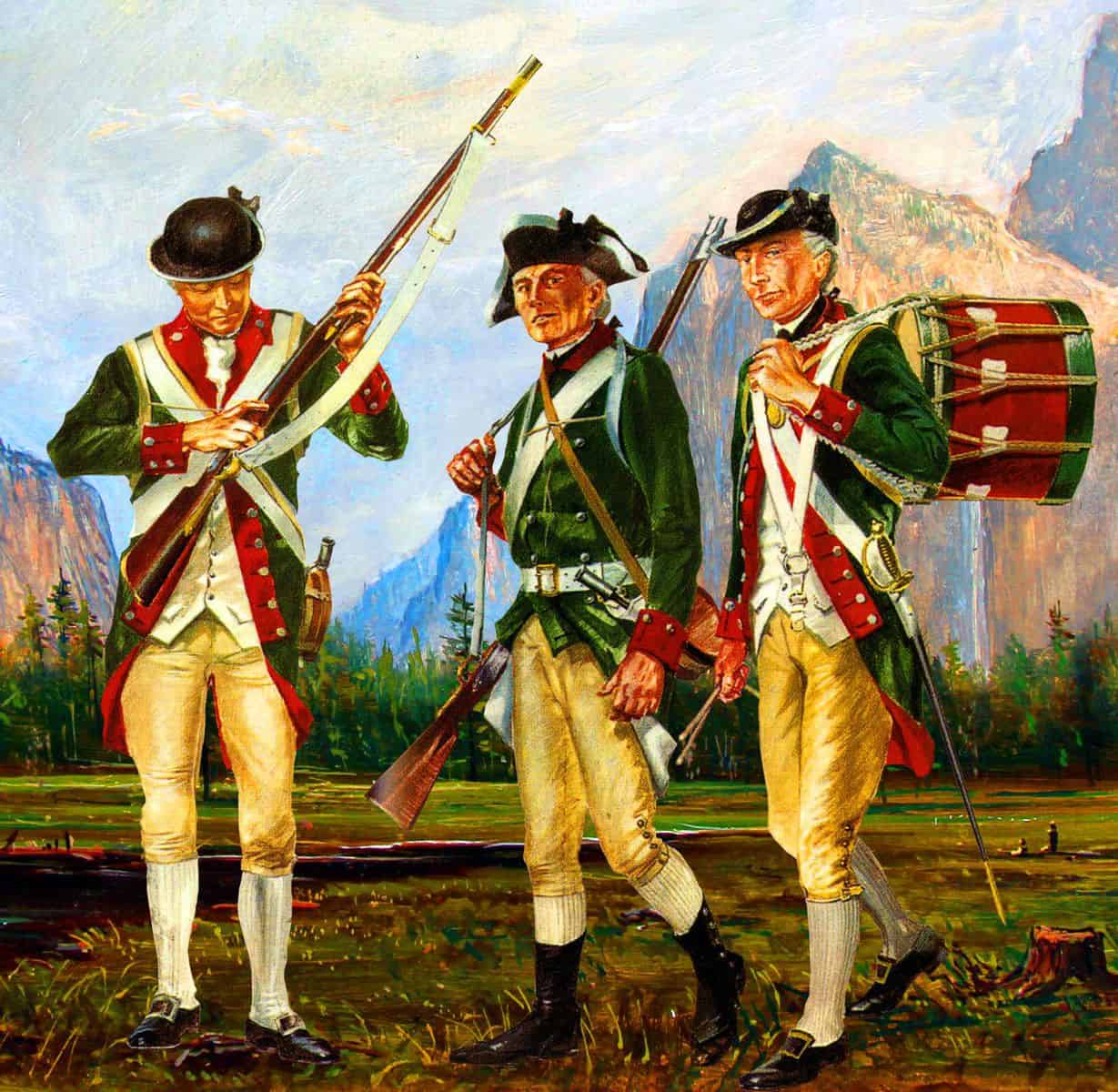 Continental Marines, circa 1777. Pintrest
The Marines’ First Action and Aftermath
The Continental Marines’ first combat operation came about because the Continental Army was hard pressed for gunpowder. Its recently appointed commander in chief, general George Washington, had asked Congress for 400 barrels of gunpowder, but his political masters responded by sending him fewer than 40 barrels – barely enough for 20 rounds per soldier. Despite Washington’s repeated remonstrations, pleas, and threats of impending disaster if his forces were not adequately supplied, no more gunpowder was forthcoming. So alternatives were sought, and it was decided that if Congress could not provide what was needed, perhaps the British would.
Virginia’s colonial governor, Lord Dunmore, had removed his colony’s stores of weapons and munitions – including gunpowder – to Nassau, New Providence Island, in the Bahamas, when the Revolutionary War erupted, to secure them against capture by the rebels. When word arrived that there were over 200 barrels of gunpowder stored in the Bahamas, Congress directed the commander of the recently established Continental Navy, Esek Hopkins, to raid the British stores and seize the desperately needed munitions. The ensuing naval operation and amphibious assault was to be the first significant engagement of the new Navy and Marines.
On February 17th, 1776, Esek Hopkins sailed from Delaware to the Bahamas with a small fleet of eight ships, accompanied by a contingent of Continental Marines under the command of captain Samuel Nicholas. Stormy weather forced two of Hopkins’ ships to turn back, but he sailed on with his remaining six vessels, finally reaching New Providence Island on March 1st. There, he promptly captured two British merchantmen off Nassau, replacing the two ship he had lost on the way there. Then, for reasons lost to history, Hopkins kept his ships anchored offshore for two days, before finally landing a force of about 200 Marines and 50 sailors on the morning of March 3rd.
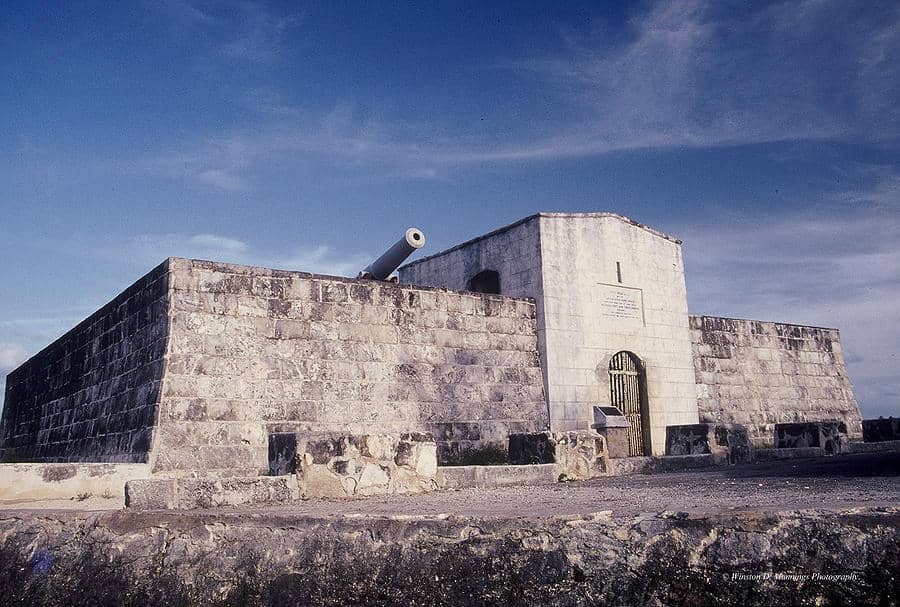 Fort Montagu in the Bahamas, the first fortification captured by an American marine amphibious landing. Fine Art America
By then, the defenders were aware that enemy vessels were operating in their waters, and when ships were spotted sailing in to Nassau, the alarm was raised. At the approach of the American forces, the outnumbered defenders evacuated Fort Montagu, one of two fortifications defending Nassau, and it was promptly occupied by captain Nicholas and his Continental Marines. Nicholas failed to continue on to and capture Nassau that day, however, and spent the night of the 3rd in Fort Montagu. That night, the British in Nassau loaded most of the gunpowder stored there – 162 barrels out 200 – aboard a ship, which managed to sneak out of the harbor and sail away to safety. The following morning, Nicholas and his men occupied Nassau, and seized the remaining 38 barrels of gunpowder, wrapping up the Continental Marines’ first major operation.
By war’s end, the Continental Marines had grown to over 2000 men. After America secured its independence in 1783, the Continental Navy was demobilized, and its Marines were disbanded. In subsequent years, however, tensions with European powers, particularly France, played out on the high seas, and America’s inability to protect its shipping or retaliate against aggression led Congress to formally reestablish the US Navy in May of 1798. Two months later, on July 11th, 1798, president John Adams signed into law a bill establishing the United States Marine Corps as a standing military force within the Department of the Navy.
_________________
Where Did We Find This Stuff? Some Sources and Further Reading
History – Birth of the US Marine Corps
Military – The Origins of the Marine Corps
Time Magazine, November 10th, 2015 – How the US Marine Corps Was Founded Twice
Varsity Tutors – The Continental Marines: The Birth of the Leathernecks
Wikipedia – History of the United States Marine Corps
Marine Corps University – Brief History of the United States Marine Corps
https://historycollection.com/the-origins-and-birth-of-the-united-states-marine-corps/#the-marines-first-action-and-aftermath
|
|
|
|
|
In 1898, a Minnesota farmer clearing trees from his field uproots a large stone covered with mysterious runes. See more in this special, ...
|
|
|
 Primer
Primer
 Anterior
2 a 9 de 9
Siguiente
Anterior
2 a 9 de 9
Siguiente
 Último
Último

|
 A drawing of one of the Templar Knights. Borstnar.
A drawing of one of the Templar Knights. Borstnar.
 A drawing of a group of Templars. Ancient Origins.
A drawing of a group of Templars. Ancient Origins.























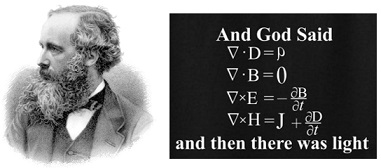







 A representation of a Knight Templar (Ten Duinen Abbey museum, 2010). Photo by JoJan CC BY 3.0/The Vintage News.
A representation of a Knight Templar (Ten Duinen Abbey museum, 2010). Photo by JoJan CC BY 3.0/The Vintage News.
 Map of Oak Island, Nova Scotia. Photo by Oaktree CC BY-SA 4.0/ The Vintage News.
Map of Oak Island, Nova Scotia. Photo by Oaktree CC BY-SA 4.0/ The Vintage News.
 A drawing of a Templar Knight on horseback. Anonymous Radio Show.
A drawing of a Templar Knight on horseback. Anonymous Radio Show.
 Island and Wharf, Oak Island, Nova Scotia, Canada, August 1931. The Vintage News.
Island and Wharf, Oak Island, Nova Scotia, Canada, August 1931. The Vintage News.
 A photograph of Franklin D. Roosevelt and others at Oak Island in Nova Scotia. The Vintage News.
A photograph of Franklin D. Roosevelt and others at Oak Island in Nova Scotia. The Vintage News.
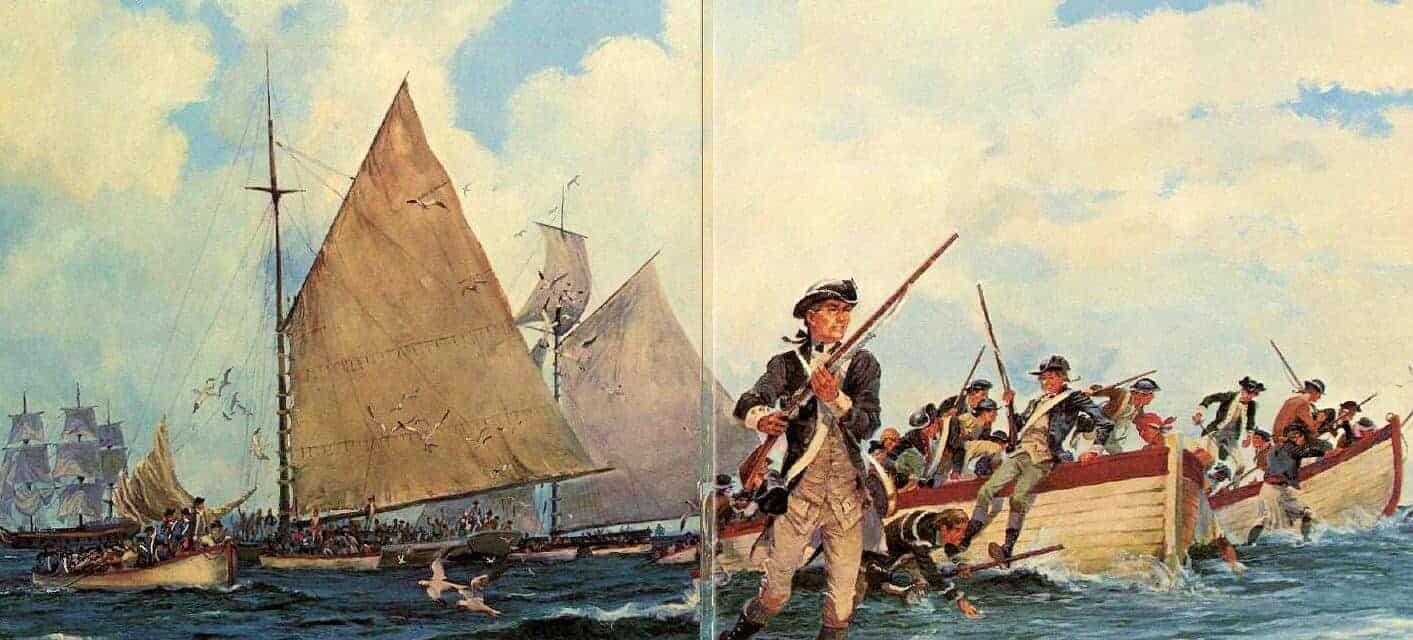
 Ancient Phoenician marine. Pintrest
Ancient Phoenician marine. Pintrest
 British Royal Marines accompanying captain Cook as he talks with South Sea islanders. Pintrest
British Royal Marines accompanying captain Cook as he talks with South Sea islanders. Pintrest
 Revolutionary war marines. Weapons and Warfare
Revolutionary war marines. Weapons and Warfare
 Tun Tavern in Philadelphia, birthplace of the United States Marine Corps during the Revolutionary War. Wikimedia
Tun Tavern in Philadelphia, birthplace of the United States Marine Corps during the Revolutionary War. Wikimedia
 Continental Marines, circa 1777. Pintrest
Continental Marines, circa 1777. Pintrest
 Fort Montagu in the Bahamas, the first fortification captured by an American marine amphibious landing. Fine Art America
Fort Montagu in the Bahamas, the first fortification captured by an American marine amphibious landing. Fine Art America


